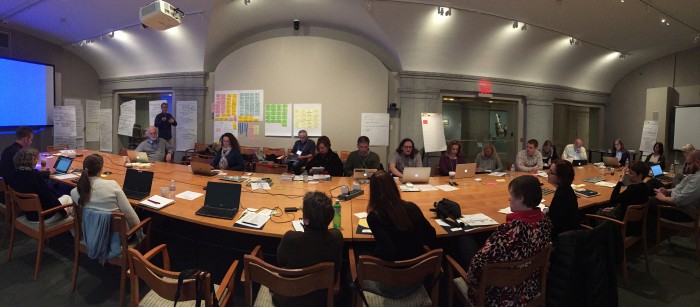Art in the Digital Age

Members of the American Art Collaborative met at the Smithsonian American Art Museum in February. (Photo courtesy SAAM)
Throughout its 169 years of existence, the Smithsonian has remained vibrant and relevant by constantly reinventing itself. That has usually been done through new buildings, systems and people. Now we’re in an era of new technology. The use of this technology by curators, conservators, researchers and educators has changed the way we do our work, and the Smithsonian’s art museums, galleries and archives are at the forefront of this change.
The Smithsonian American Art Museum, with the help of a grant from the Andrew W. Mellon Foundation, is the lead museum in The American Art Collaborative, a consortium of 14 museums in the U.S. that are uniting their collections with Linked Open Data . SAAM hosted the members of the AAC in February to begin this project, which will allow people to search for detailed information about American art and share it in a more comprehensive and intuitive way. When looking for art by Georgia O’Keeffe, for example, you will be able to see her Yellow Calla painting at SAAM, the timeless black-and-white portrait of her by Arnold Newman at the National Portrait Gallery, her handwritten letter to friend and fellow artist Cady Wells at the Archives of American Art, and samples from all of the other AAC collections across the country. The O’Keeffe letter is just one example of the nearly 1.8 million photos and documents available on the Archives of American Art website. Going digital is allowing information about art and artists to be accessed more readily by researchers and enthusiasts alike.
Access is at the heart of the Freer Gallery of Art and Arthur M. Sackler Gallery’s January release of their entire collections online. Through a free public platform called Open F|S, anyone can explore and download high-resolution images of more than 40,000 artworks. Most have never been seen by the public, and open access allows for free non-commercial use without copyright restrictions. Digital technology is also changing the way artists express their creativity.

Guido van der Werve, Still from Nummer Negen (#9) The Day I Didn’t Turn with the World, 2007. Hirshhorn Museum and Sculpture Garden, Smithsonian Institution, Washington DC. © Guido van der Werve
At the Hirshhorn Museum and Sculpture Garden, the artists in the exhibition Days of Endless Time attempt to subvert the ephemeral nature of digital media, using those media to do so. For instance, Clemens von Wedemeyer’s Afterimage is a panoramic video with the camera taking us on a tour of a studio filled with replicas of ancient sculpture used in Italian cinema. The realistic effect is a result of animation created with laser scanning and imaging software. Siebren Versteeg’s work Neither There Nor There features a picture of the artist digitally pixellating between two video screens as if he were transporting on and off the Star Trek bridge. And NPG increasingly acquires portraiture derived from digital sources, most recently the 3D-scanned bust of President Obama, the first ever for a sitting president, conducted by our digitization program office. The benefit of 3D scanning is evident in the Freer Gallery of Art’s sixth century Chinese “Cosmic Buddha” sculpture that is one of the twenty items in our collections that have been scanned. Not only can researchers do in-depth study of it by computer, the highly detailed mapping of its surface actually allowed scholars to revise the age of the sculpture. For education and scholarship, digitizing art can open up new possibilities.

A 3-D printed bust of President Barack Obama is the first presidential portrait created using 3-D technology. The prints and the 3-D data are now part of the collection of the National Portrait Gallery.
One of the most dramatic examples of the changing Smithsonian is the newly renovated Cooper Hewitt, Smithsonian Design Museum. The transformed Carnegie Mansion, the museum’s home, is a true interactive experience, inviting visitors to use digital tools to explore the collection, create their own designs, and save and share those designs. The innovative integration of technology into the traditional museum has led The Atlantic to proclaim, “The museum of the future is here.” I couldn’t agree more.
In the digital strategy of the Tate in London, director Nicholas Serota exhorts museums to be places “where people across the world will have a conversation. Those institutions which take up this notion fastest and furthest will be the ones which have the authority in the future.” At the Smithsonian, we are at the forefront of this transition to the digital world. Doing so is allowing us to reach more students, parents, teachers, artists, and enthusiasts than ever before—and with a more powerful voice that will resonate more deeply than ever before. That’s how we innovate, and it is how we continue to be a dynamic organization that boldly serves people all across the United States and throughout the world.
Posted: 27 February 2015



